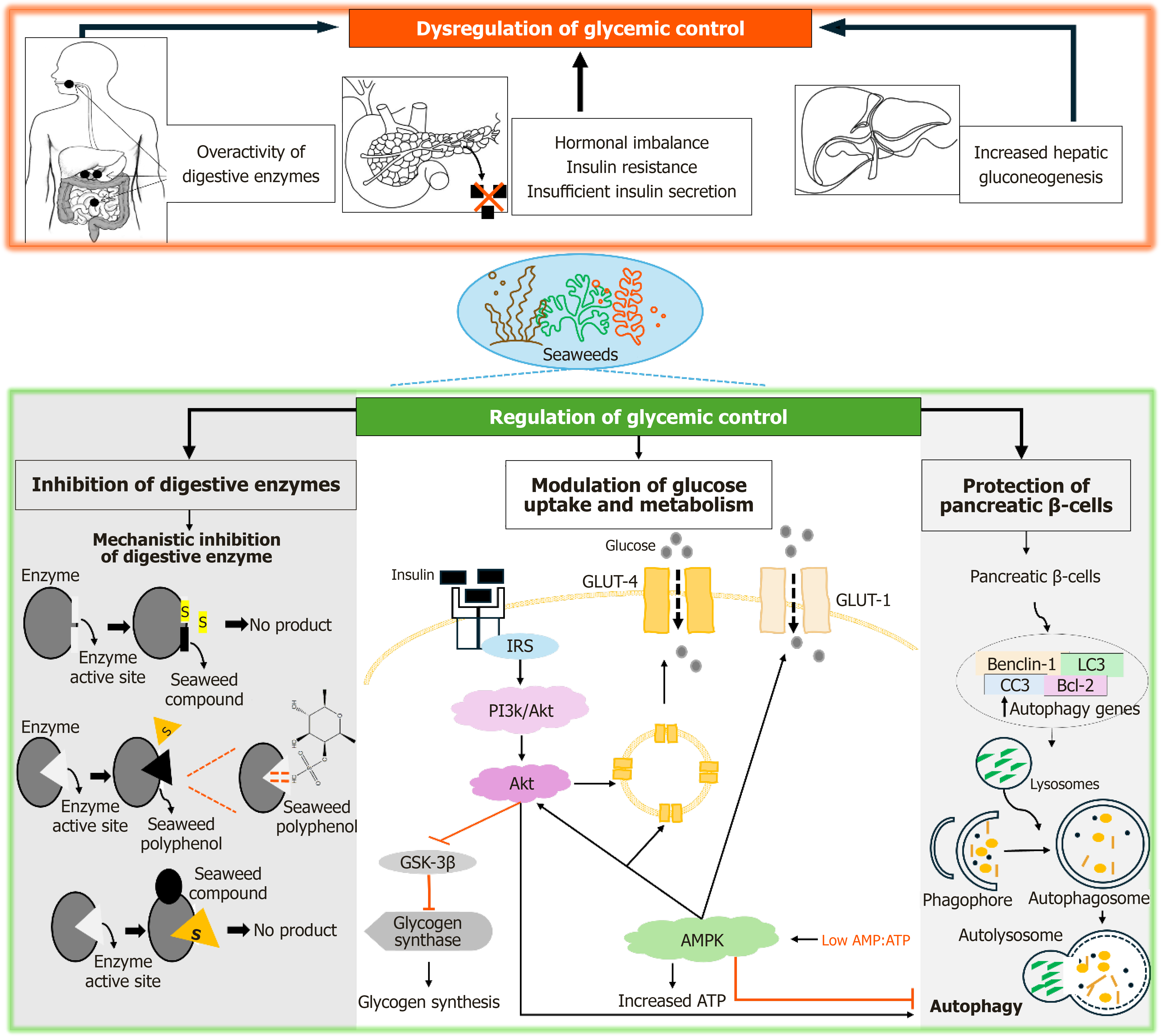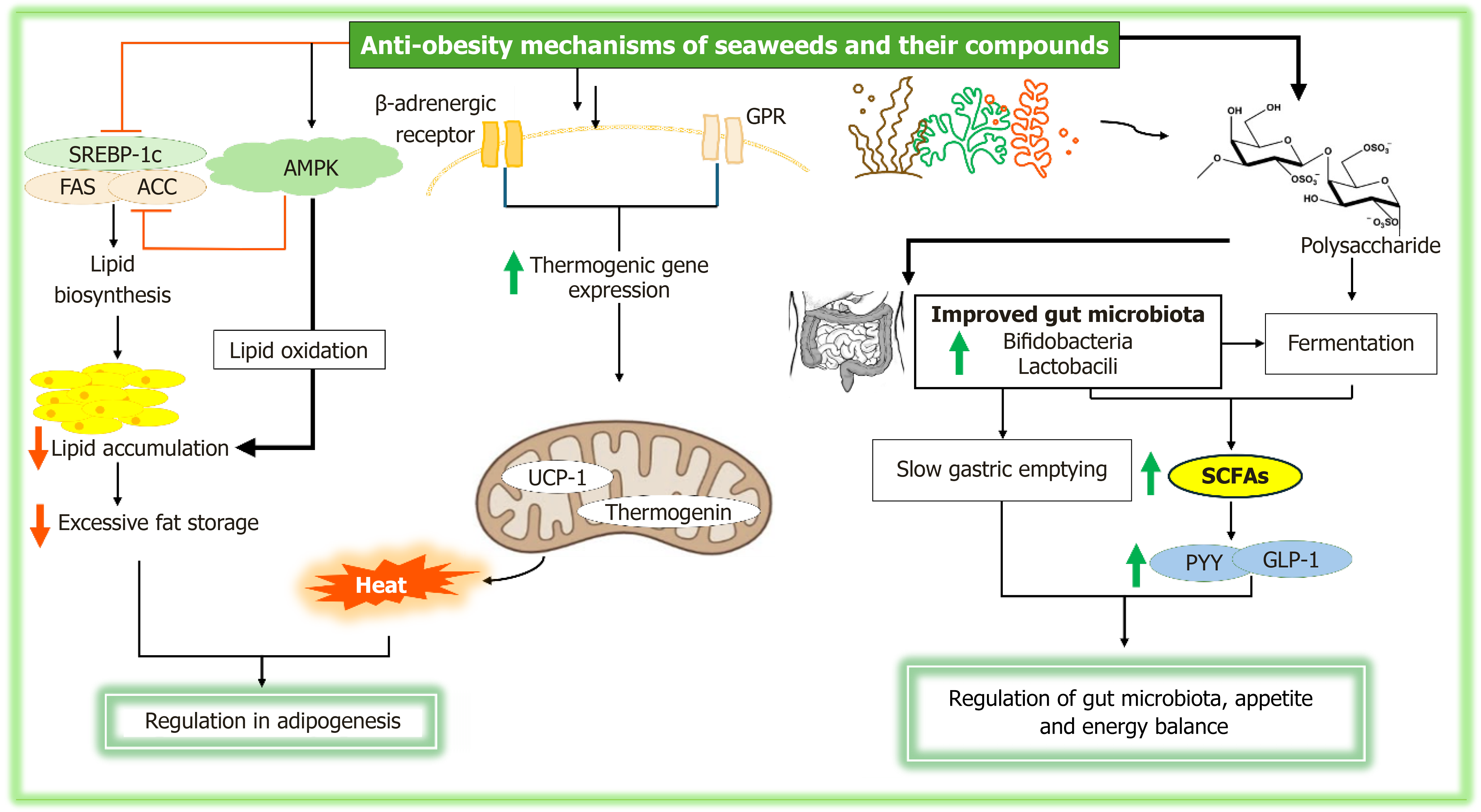Copyright
©The Author(s) 2025.
World J Diabetes. Nov 15, 2025; 16(11): 112847
Published online Nov 15, 2025. doi: 10.4239/wjd.v16.i11.112847
Published online Nov 15, 2025. doi: 10.4239/wjd.v16.i11.112847
Figure 1 Examples seaweed species classified by pigment group.
A and B: Rhodophyta [Ceramium capense (Voucher number: NU0092414) and Gelidium pristoides (Voucher number: NU0092402)]; C and D: Phaeophyceae [Laminaria setchelli (voucher number: NU0092411) and Sargassum elegans (voucher number: NU0092416)]; E and F: Chlorophyta [Ulva fasciata (voucher number: NU0092397) and Ulva intestinalis (voucher number: NU0092420)]. The seaweeds were identified at Bews Herbarium, University of KwaZulu-Natal, Pietermaritzburg, South Africa.
Figure 2
Seaweeds as a rich source of bioactive phytochemicals and their potential applications in functional foods, nutraceuticals, and pharmaceuticals.
Figure 3 The dysregulation of glycemic control and the antidiabetic effects of seaweeds and their compounds, involving molecular mechanisms of glycemic control regulation through inhibition of digestive enzymes, modulation of glucose uptake, insulin sensitivity and secretion, and protection of pancreatic beta cells.
GLUT: Glucose transporter; IRS: Insulin receptor substrates; AMPK: Adenosine monophosphate-activated protein kinase; ATP: Adenosine triphosphate; PI3K: Phosphatidylinositol 3-kinase; Akt: Protein kinase B; AMP: Adenosine monophosphate.
Figure 4 Inflammation and oxidative stress in diabetes and the inhibition of these processes by seaweeds and their compounds, involving mechanisms of action that modulate inflammatory pathways such as inhibition of nuclear factor kappa-B, cyclooxygenase, lipoxygenase, MAPK, NRLP-3, and caspase-1, and enhance antioxidant defense systems including nuclear factor erythroid 2-related factor 2 pathway.
NF-κB: Nuclear factor kappa-B; COX: Cyclooxygenase; LOX: Lipoxygenase; TNF-α: Tumor necrosis factor α; IL: Interleukin-6; Treg: Regulatory T cell; ROS: Reactive oxygen species; HO-1: Heme oxygenase-1; GPx: Glutathione peroxidase; SOD: Superoxide dismutase; ERK: Extracellular signal-regulated kinase; JNK: C-Jun N-terminal kinase; Nrf2: Nuclear factor erythroid 2-related factor 2.
Figure 5 The anti-obesity effects of seaweeds and their compounds, showing their role in regulating adipogenesis, appetite, and energy balance, as well as modulating gut microbiota to promote weight management and overall metabolic health.
AMPK: Adenosine monophosphate-activated protein kinase; SREBP: Sterol regulatory element-binding protein 1c; FAS: Fatty acid synthase; ACC: Acetyl-CoA carboxylase; UCP-1: Uncoupling protein-1; SCFAs: Short-chain fatty acids; PYY: Peptide YY; GLP: Glucagon-like peptide-1.
- Citation: Magwaza SN, Islam MS. Mechanisms behind the anti-diabetic and anti-obesity effects of seaweeds or macroalgae and their bioactive compounds. World J Diabetes 2025; 16(11): 112847
- URL: https://www.wjgnet.com/1948-9358/full/v16/i11/112847.htm
- DOI: https://dx.doi.org/10.4239/wjd.v16.i11.112847

















